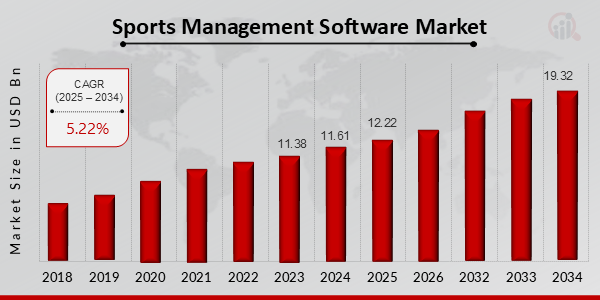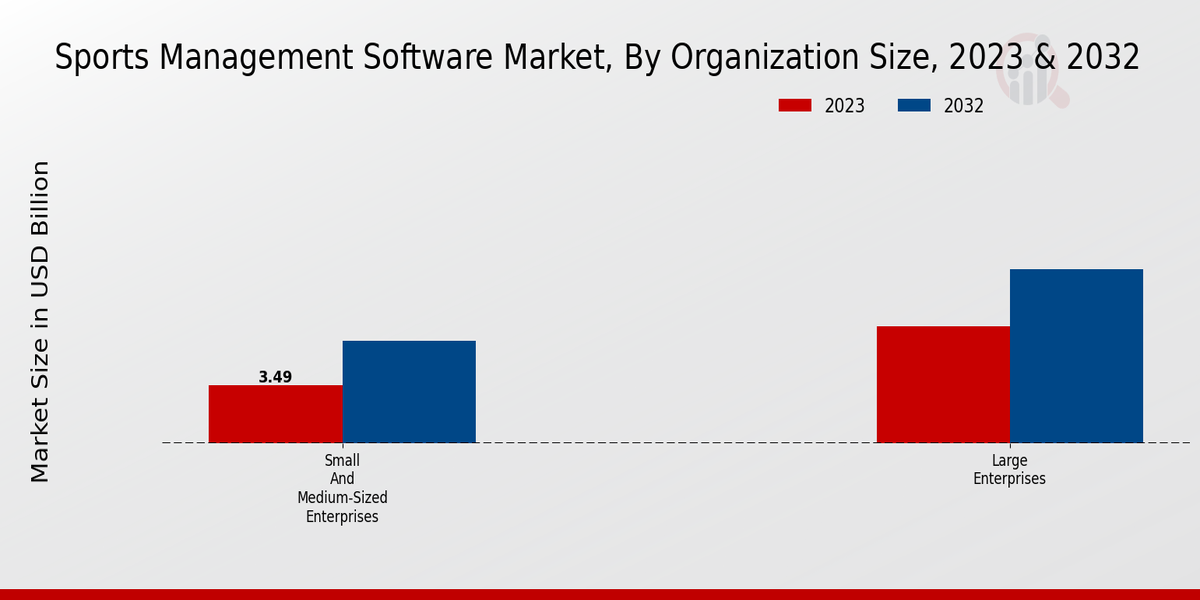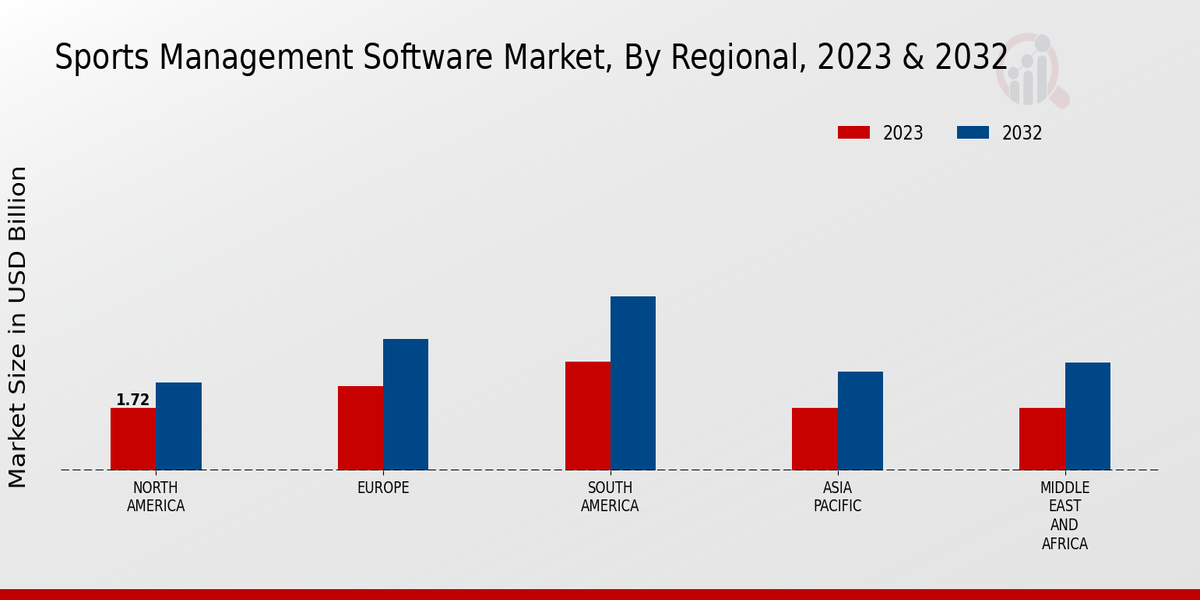Sports Management Software Market Overview
Sports Management Software Market is projected to grow from USD 12.22 Billion in 2025 to USD 19.32 Billion by 2034, exhibiting a compound annual growth rate (CAGR) of 5.22% during the forecast period (2025 - 2034).
Additionally, the market size for Sports Management Software Market was valued at USD 11.61 billion in 2024.
Key Sports Management Software Market Trends Highlighted
Key market drivers for sports management software include the growing popularity of sports, increasing investment in sports infrastructure, and the need for effective athlete management. Opportunities arise in data analytics, injury prevention, and athlete performance optimization. Recent trends have emphasized the adoption of cloud-based solutions, mobile applications, and wearable technology. Cloud computing offers flexibility, scalability, and cost-effective access to software. Mobile apps empower athletes and coaches to access information and manage schedules on the go. Wearable technology enables real-time data collection and analysis, providing valuable insights into athlete performance and recovery. These advancements enhance the efficiency and effectiveness of sports management operations.
Figure 1: Sports Management Software Market size 2025-2034

Source: Primary Research, Secondary Research, MRFR Database and Analyst Review
Sports Management Software Market Drivers
Rising Demand for Data Analytics in Sports
The increasing adoption of data analytics in the sports industry is a major driver of the growth of the Sports Management Software Market Industry. Data analytics provides valuable insights into player performance, team dynamics, and fan engagement, which helps teams make informed decisions and improve their performance. The demand for sports management software that can effectively collect, analyze, and visualize data is expected to continue to grow in the coming years, as teams look to gain a competitive edge through data-driven insights. In addition to providing insights into player performance, data analytics can also be used to improve fan engagement. By tracking fan behavior and preferences, teams can create targeted marketing campaigns and personalized experiences that increase fan loyalty and revenue.
The growing use of data analytics in sports is expected to continue to drive the demand for sports management software, as teams look to leverage data to improve their performance and fan engagement. Some of the key benefits of using data analytics in sports include: Improved player performance: Data analytics can be used to track player performance and identify areas for improvement. This information can then be used to develop personalized training programs and strategies to help players improve their skills and performance.
Enhanced team dynamics: Data analytics can be used to analyze team dynamics and identify areas for improvement.This information can then be used to develop team-building exercises and strategies to improve communication, collaboration, and teamwork. Increased fan engagement: Data analytics can be used to track fan behavior and preferences. This information can then be used to create targeted marketing campaigns and personalized experiences that increase fan loyalty and revenue. The growing adoption of data analytics in sports is expected to continue to drive the growth of the Sports Management Software Market Industry in the coming years.
Increasing Adoption of Cloud-Based Sports Management Software
In addition, the adoption of sports management software is increasing with the growing popularity of cloud-based software. It is easier to use cloud-based software since no hardware and software need to be procured. Since the software is used through the internet, data is easily accessed online. Since there is no requirement to be there in person to manage the operations of a sports team, the software is in use in multiple locations across the globe. There is a high increase in the number of teams that use cloud-based software to manage their operations.
Data is stored in one place for retrieval of information whenever needed. Therefore, purchases on lost data can be minimised through performance tracking of the team’s history. With most of the teams moving their managements online, there is an increase in the uptake of cloud-based sports management software.
Government Initiatives to Promote Sports Participation
Government initiatives to promote sports participation are also driving the growth of the Sports Management Software Market Industry. In many countries, governments are investing in sports infrastructure and programs to encourage people to participate in sports. This is leading to an increase in the number of people playing sports, which in turn is driving the demand for sports management software. Government initiatives to promote sports participation are typically focused on the following areas:
Building new sports facilities: Governments are investing in the construction of new sports facilities, such as stadiums, gymnasiums, and swimming pools.This is making it easier for people to access and participate in sports. Funding sports programs: Governments are also providing funding for sports programs, such as youth sports leagues and after-school programs. This is helping to make sports more accessible and affordable for people of all ages.
Sports Management Software Market Segment Insights
Sports Management Software Market Organization Size Insights
The segmentation of the Sports Management Software Market by organization size into Small and Medium-Sized Enterprises (SMEs) and Large Enterprises provides valuable insights into the varying needs and adoption patterns within the industry. SMEs, characterized by their limited resources and operational scale, often prioritize cost-effective solutions that cater to their core business functions. In 2023, SMEs accounted for approximately 45% of the Sports Management Software Market revenue, driven by the increasing adoption of cloud-based and SaaS (Software as a Service) solutions that offer flexible and scalable options.
Large Enterprises, on the other hand, possess greater financial and operational capabilities, enabling them to invest in comprehensive and feature-rich sports management software solutions. This segment is expected to witness significant growth over the forecast period, driven by the rising demand for advanced analytics, data management, and performance optimization capabilities.
Leading vendors in the Sports Management Software Market are continuously innovating and expanding their offerings to cater to the evolving needs of both SMEs and Large Enterprises. The availability of tailored solutions and flexible pricing models is expected to further fuel the adoption of sports management software across all organization sizes.
Figure 2: Sports Management Software Market 2023-2032

Source: Primary Research, Secondary Research, MRFR Database and Analyst Review
Sports Management Software Market Deployment Type Insights
The deployment type segment of the Sports Management Software Market consists of Cloud-Based and On-Premise. The Cloud-Based segment is anticipated to lead the market over the forecast period due to its cost-effectiveness, scalability, and flexibility. The research shows that the Cloud-Based segment will generate a share of about 65% of the Sports Management Software Market revenue by 2026. Conversely, the On-Premise segment is anticipated to exhibit a slow growth trend as a result of the increasing need for data security and control.
However, market growth is expected to be curtailed by the excessive upfront costs and maintenance costs of On-Premise solutions. Overall, the Sports Management Software Market segmentation offers valuable information on the market trends and assists stakeholders in making wise decisions.
Sports Management Software Market Functionality Insights
The functionality segment of the Sports Management Software Market is expected to grow significantly in the coming years, driven by the increasing adoption of sports management software solutions by sports organizations. Scheduling and event management software is expected to hold the largest market share in this segment, as it helps organizations manage and automate their scheduling and event planning processes, leading to increased efficiency and reduced costs. Player management software is another important segment, as it provides organizations with the tools to manage player contracts, performance data, and other player-related information.
Team and league management software is also expected to see significant growth, as it helps organizations manage team rosters, schedules, and other league-related information. Financial management software is essential for sports organizations to manage their finances and ensure compliance with financial regulations. Data analytics and reporting software is also becoming increasingly important, as it allows organizations to track and analyze performance data to identify trends and make informed decisions. Overall, the functionality segment of the Sports Management Software Market is expected to continue to grow rapidly in the coming years, as sports organizations increasingly adopt these solutions to improve their operations and achieve their goals.
Sports Management Software Market Sport Type Insights
The Sport Type segment plays a crucial role in shaping the Sports Management Software Market landscape, with varied needs and preferences across different sports. Team Sports, which encompass popular games like basketball, soccer, and football, accounted for a significant share of the market in 2023 and are projected to continue their dominance in the coming years. The demand for sports management software in this segment stems from the need to manage complex team dynamics, track player performance, and optimize training and game strategies.
On the other hand, Individual Sports, such as tennis, golf, and swimming, represent a growing segment, driven by the increasing popularity of fitness and recreational activities. These sports require specialized software solutions tailored to individual athlete development, performance analysis, and personalized training plans. Fitness and Recreation Activities, encompassing a wide range of non-competitive sports and fitness pursuits, also contribute to the market growth, as software solutions help manage facility operations, membership tracking, and personalized fitness programs.
Sports Management Software Market Regional Insights
The regional segmentation of the Sports Management Software Market offers valuable insights into market growth and dynamics. North America is projected to hold a significant market share, driven by the presence of numerous sports leagues, teams, and organizations. Europe follows closely, benefitting from a large number of sports clubs, federations, and events.
The APAC region is expected to witness robust growth due to rising investments in sports infrastructure and increasing popularity of sports. South America and MEA are emerging markets with potential for expansion as sports management becomes more organized and sophisticated.The Sports Management Software Market segmentation provides a comprehensive understanding of regional market dynamics, enabling stakeholders to tailor their strategies and capture growth opportunities.
Figure 3 : Sports Management Software Market 2023-2032

Source: Primary Research, Secondary Research, MRFR Database and Analyst Review
Sports Management Software Market Key Players And Competitive Insights
Major players in Sports Management Software Market are investing heavily in research and development to enhance their product offerings and gain a competitive edge. These companies are focusing on developing innovative solutions that meet the evolving needs of sports organizations and athletes. The Sports Management Software Market industry has witnessed a surge in strategic partnerships, mergers, and acquisitions, as players seek to expand their market reach and strengthen their competitive position. Leading Sports Management Software Market players are also actively involved in collaborations with technology providers to integrate advanced technologies such as artificial intelligence (AI), machine learning (ML), and data analytics into their software solutions. This strategic move enables them to provide more comprehensive and data-driven insights to their customers, enhancing their decision-making and improving their overall performance.
A notable example of a leading company in the Sports Management Software Market is TeamSnap, which has established itself as a prominent player in the industry. The company offers a comprehensive suite of software solutions designed specifically for youth sports organizations. TeamSnap's software helps teams manage schedules, rosters, payments, and communication, streamlining operations and enhancing overall efficiency. The company's commitment to innovation and customer satisfaction has contributed to its strong market position. TeamSnap's software is used by over 20 million coaches, parents, and athletes worldwide, making it one of the most popular sports management software solutions available.
On the other hand, a significant competitor in the Sports Management Software Market is SportsEngine. The company provides a comprehensive platform for sports organizations of all sizes, from youth leagues to professional teams. SportsEngine's software includes features such as team management, event scheduling, registration and payment processing, website creation, and mobile applications. The company's focus on providing a user-friendly and feature-rich platform has made it a popular choice among sports organizations looking to streamline their operations and improve their overall performance. SportsEngine's software is used by over 1 million sports organizations worldwide, making it a formidable competitor in the market.
Key Companies in the Sports Management Software Market Include
- TeamHub
- Teamgage
- WiseTeam
- SportsRec
- TeamSideline
- SportEasy
- TeamSnap
- TeamGenius
- PlayerLync
- SportsEngine
- Sideline
- Sports Connect
- LeagueApps
- Blue Star Sports
Sports Management Software Market Industry Developments
The Sports Management Software Market is expected to reach USD 16.59 billion by 2032, exhibiting a CAGR of 5.22% during the forecast period (2024-2032). The growing adoption of cloud-based sports management solutions, increasing demand for data analytics and performance tracking tools, and rising investments in sports infrastructure are driving market growth. Key market players are focusing on strategic partnerships, acquisitions, and product innovations to expand their offerings and gain a competitive edge. Recent developments include:
- In 2023, Sports Connect acquired TeamStats, a provider of sports management software for youth and recreational sports organizations.
- In 2024, PlaySight partnered with Hudl to integrate video analysis capabilities into its sports management platform.- In 2025, SAP launched SAP Sports One, a cloud-based sports management solution designed for professional sports organizations.
Sports Management Software Market Segmentation Insights
-
Sports Management Software Market Organization Size Outlook
- Small and Medium-Sized Enterprises (SMEs)
- Large Enterprises
-
Sports Management Software Market Deployment Type Outlook
-
Sports Management Software Market Functionality Outlook
- Scheduling and Event Management
- Player Management
- Team and League Management
- Financial Management
- Data Analytics and Reporting
-
Sports Management Software Market Sport Type Outlook
- Team Sports (e.g., Basketball, Soccer, Football)
- Individual Sports (e.g., Tennis, Golf, Swimming)
- Fitness and Recreation Activities
-
Sports Management Software Market Regional Outlook
- North America
- Europe
- South America
- Asia Pacific
- Middle East and Africa
|
Report Attribute/Metric
|
Details
|
|
Market Size 2024
|
11.61 (USD Billion)
|
|
Market Size 2025
|
12.22 (USD Billion)
|
|
Market Size 2034
|
19.32 (USD Billion)
|
|
Compound Annual Growth Rate (CAGR)
|
5.22% (2025 - 2034)
|
|
Report Coverage
|
Revenue Forecast, Competitive Landscape, Growth Factors, and Trends
|
|
Base Year
|
2024
|
|
Market Forecast Period
|
2025 - 2034
|
|
Historical Data
|
2019 - 2023
|
|
Market Forecast Units
|
USD Billion
|
| Key Companies Profiled |
TeamHub, Teamgage, WiseTeam, SportsRec, TeamSideline, SportEasy, TeamSnap, TeamGenius, PlayerLync, SportsEngine, Sideline, Sports Connect, LeagueApps, Blue Star Sports |
| Segments Covered |
Organization Size, Deployment Type, Functionality, Sport Type, Regional |
| Key Market Opportunities |
Cloudbased solutions Artificial intelligence Mobile optimization Data analytics Personalized experiences |
| Key Market Dynamics |
CloudBased Deployment Adoption AIPowered Analytics Data Security Enhancements Mobile Application Integration Ecommerce Functionality |
| Countries Covered |
North America, Europe, APAC, South America, MEA |
Frequently Asked Questions (FAQ) :
The Sports Management Software Market is projected to reach 10.49 Billion USD in 2023.
The Sports Management Software Market is projected to grow at a CAGR of 5.22% from 2023 to 2034
North America is expected to hold the largest market share in the Sports Management Software Market in 2023.
The league management segment is expected to hold the largest market share in the Sports Management Software Market in 2023.
Some of the key competitors in the Sports Management Software Market include SAP, Oracle, IBM, Microsoft, and Sportradar.
The key trends driving the growth of the Sports Management Software Market include the increasing adoption of cloud-based solutions, the growing popularity of sports analytics, and the rising demand for mobile-friendly solutions.
The challenges facing the Sports Management Software Market include the high cost of implementation, the lack of standardization, and the security concerns associated with cloud-based solutions.
The Sports Management Software Market is projected to reach 19.32 Billion USD by 2034
Asia Pacific is expected to have the highest growth rate in the Sports Management Software Market from 2023 to 2034
Some of the key opportunities in the Sports Management Software Market include the growing adoption of AI and machine learning, the increasing demand for personalized solutions, and the expansion of the sports industry into new markets

















